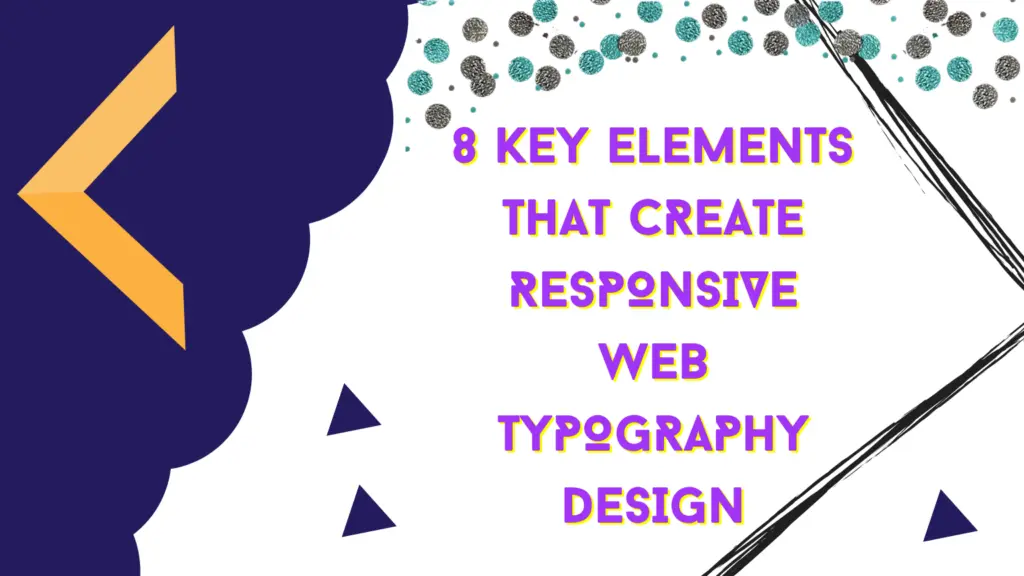8 key elements that create responsive web typography design
8 key elements that create responsive web typography design
1. Typeface
Choosing a typeface for a responsive plan is the initial step. As a guideline, there ought not be multiple typefaces, however a limit of two is most likely best. Search for well known typefaces. Open Sans, a sans-serif typeface, gives off an impression of being the pattern existing apart from everything else. Serif typefaces might be appropriate for headings, while sans-serif typefaces are better for body duplicate. Assuming that you are keen on scrutinizing text styles, look at these two incredible web text style libraries-Google Fonts and Font Squirrel.
2. Hierarchy
Typographic pecking order is a deliberate approach to coordinating typefaces to lay out a request for significance inside the substance. It assists with directing the pursuer’s eye to the most conspicuous substance that ought to be seen first, next, etc. Order is imperative in assisting the peruser with exploring through the page’s items without passing up the most essential snippets of data. For instance, headings are consistently bigger than sub-headings and standard text. There are four variables in making a decent pecking order:
- Size
- Colour
- Alignment
- Contrast
3. Colour
Clients love brilliant sites, yet picking the right one among 1,000 varieties requires a prepared eye. This is where website specialists can release their imagination and hoist the connection point to an unheard of level. Be that as it may, a fair warning. Picking the text tone requires artfulness. It ought to highlight the correct method for passing on the message in the right tone. Miss the point entirely, and it can bring about an untidy, tumultuous tangle of varieties.
4. Contrast
In typography, contrast implies that no two components are something very similar, right from the variety, text dimension, weight, scale, and dispersing. Be that as it may, the difference ought to be amicable to make a stylish equilibrium and make the page intriguing and significant. To make eye catching differences, you can attempt different varieties, text styles, text dimensions, and styles and separate the page with a fascinating turn.
5. Consistency
Consistency is generally connected with the typefaces utilized on a website page. Assuming ordered progression is significant, consistency features it and passes on the data how it was planned. Lay out consistency by adhering to a similar textual style to make an observable, comprehensible example. A triumphant recipe for consistency is to involve one textual style for headings, one more for subheadings and stick to it.
6. Text Readability
Web content perusing isn’t similar to book perusing. Guests generally skim through the page to get the essence of the substance instead of perusing it word-by-word. It is hence that text intelligibility and its parts are given more than adequate significance. There are four parts to message clarity:
- Letter spacing
Otherwise called following, it alludes to the even void area between the letters in a sentence or section. Dividing influences the visual thickness of a page. Intently divided words show up more conservative, while broadly dispersed words render a vaporous appearance. Try to keep a right space between words to upgrade the text’s meaning
- Line spacing
Line spacing refers to the vertical space between two lines in a text. It holds the same significance in determining text readability by making it easy for the reader to skim from one line to the next.
- Line length
Line length is defined by the number of characters on each line rather than the number of words. The ideal line length is 45-85 characters per line. Anything longer or shorter will affect the readability. Lengthy lines will impact the reader’s focus, and very short ones will break the reading rhythm.
- Text alignment
How have you aligned your web page content? Is it aligned left, right, or in the center? Text alignment is a design choice that requires a careful thought process because it impacts your page hierarchy and text readability. Good alignment draws the reader’s eye to the content and keeps them anchored as they know where each line starts and ends.

